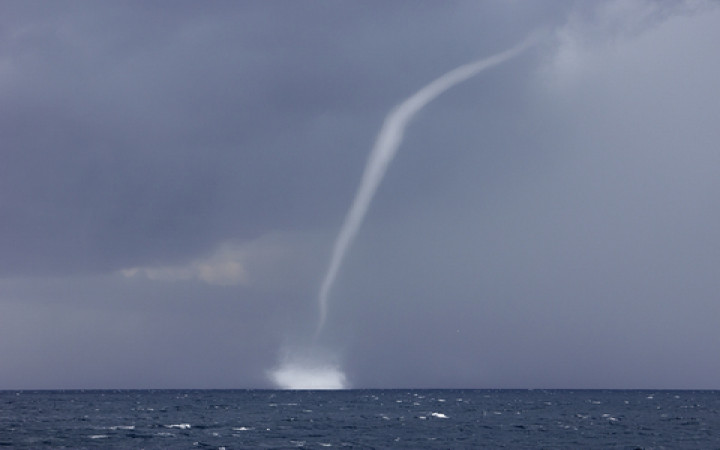Today’s Wonder of the Day was inspired by Kaitlyn. Kaitlyn Wonders, “How do waterspouts form?” Thanks for WONDERing with us, Kaitlyn!
Have you ever taken a bath and seen the water drain out of the tub? You may often see a tiny whirlpool. The water spins around, creating a vortex. But what would happen if suddenly that spinning water went up in the air? That would be a waterspout! Let’s WONDER together—what is a waterspout?
A waterspout is a large column of spinning water and air. It looks like a tornado over the water. It has a lot in common with a tornado, though they are not the same things. Some waterspouts, like tornadoes, happen because of bad weather. These are called tornadic waterspouts. Tornadic waterspouts can happen when tornadoes move from land to water. They can also be caused by severe storms. Like tornadoes, tornadic waterspouts can be destructive and dangerous.
The other kind of waterspouts are called fair weather waterspouts. They can happen even in good weather. While tornadic waterspouts move downward from clouds to the water, fair weather waterspouts seem to form at the surface of the water. Fair weather waterspouts are much more common than tornadic waterspouts.
Scientists are still learning about how fair weather waterspouts form. We do know that they need warm water to develop. That means that they are most common in areas where the water is warmer—the Florida Keys, off the coast of Greece, and on the east coast of Australia are just some places they can be seen. But waterspouts can form anywhere around the world, if the water is warm enough. They can even be seen in the Great Lakes of the U.S.!
Another piece of the waterspout puzzle is in the sky. Waterspouts develop from cumulus clouds. Cumulus clouds are the most common type of cloud: white, fluffy, and shaped kind of like cauliflower. When cumulus clouds form over warm water, they can grow much larger. If there are the right kinds of clouds present—along with light wind, high humidity, and warm water—there is a good chance for a waterspout!
We also know the stages of fair weather waterspouts. The first stage is a dark spot on the surface of the water. This is where the vortex, or column of spinning water and air, will form. Next, a light and dark spiral pattern forms around the dark spot. In stage 3, a ring of sea spray develops. It looks like it has an “eye” like a hurricane. This spray ring is called a cascade. Stage 4 is when the waterspout can be seen. This stage is called the mature vortex. The last stage is where the vortex decays, or collapses, and the waterspout disappears.
You may be WONDERing, how is a waterspout different from a tornado? Scientists used to think that they were almost the same. Now we know that while tornadic waterspouts are similar to tornadoes, fair weather waterspouts are different. While tornadoes usually form as part of a larger storm, fair weather waterspouts start in just that—fair, or calm, weather. Waterspouts are also weaker than most tornadoes. Tornadoes are measured on a scale of 0–5. Fair weather waterspouts only reach level 0. This makes fair weather waterspouts not as destructive as tornadoes. They can be dangerous for people in small watercraft or swimming, though.
There are other weather phenomena like tornadoes and waterspouts. In fact, waterspouts are a kind of whirlwind. A whirlwind is a column of swirling air that makes a vortex. When a whirlwind happens over water, it is called a waterspout. Whirlwinds can also happen with dust, to create a dust devil, or with fire, to cause a firestorm. There are even “snowspouts” and “haywhirls.” Many things can combine with wind and the right weather conditions to make whirlwinds.
Have you ever seen a waterspout or another kind of whirlwind? How would you stay safe if you did see one?
Standards: CCRA.R.1, CCRA.R.2, CCRA.R.8, CCRA.R.10, CCRA.L.1, CCRA.L.2, CCRA.L.3, CCRA.L.4, CCRA.L.5, CCRA.L.6, CCRA.W.3, CCRA.W.4, CCRA.W.6, CCRA.SL.2, NGSS.ESS2-1, NGSS.ESS3-1




